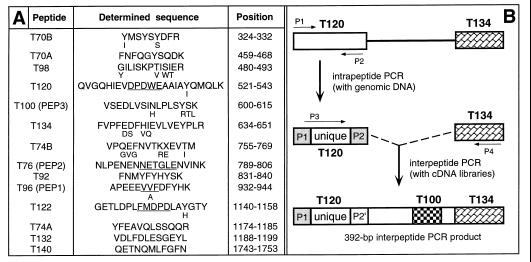Figure 1.
Peptides of rabbit UBR1p (E3α) and isolation of the mouse Ubr1 cDNA. (A) Amino acid sequences of tryptic peptides of the purified rabbit UBR1p (see Materials and Methods). The alternative sets of peptide names, T-based and PEP1-PEP3 (in parentheses), refer to two different preparations of E3α. The sequences of T120, T76, T96, and T122 that were encoded by DNA sequences identified through intrapeptide PCR are underlined. Residues deduced from the mouse Ubr1 cDNA that differed from those inferred through peptide sequencing are indicated in a smaller font. The peptides’ positions in the deduced sequence of mouse UBR1p are indicated. (B) The intrapeptide/interpeptide-PCR cloning strategy. The products of the initial intrapeptide PCR, derived from rabbit genomic DNA, were used to carry out interpeptide PCRwith a rabbit liver cDNA library (CLONTECH). The resulting 392-bp fragment of the rabbit Ubr1 cDNA was used to isolate, using PCR and a λgt11 mouse liver cDNA library, the corresponding 392-bp mouse Ubr1 cDNA fragment. This fragment then was used to screen the same cDNA library, yielding a 2.4-kb fragment of the mouse Ubr1 cDNA that encoded several of the peptide-derived sequences of the rabbit UBR1p. The encoded sequence was also significantly similar to that of the N-terminal region of S. cerevisiae Ubr1p (13) and contained the putative start (ATG) codon of the mouse Ubr1 ORF. To isolate the rest of the 5′ region of the Ubr1 cDNA, 5′-rapid amplification of cDNA ends (RACE)–PCR (20) was performed with poly(A)+ RNA from mouse L cells and a primer from the 2.4-kb DNA fragment. 3′-RACE–PCR (20) was used to amplify a downstream region of Ubr1 cDNA. The resulting DNA fragment (nucleotides 2,470–3,467) then was used to screen a λgt10 mouse cDNA library from MEL-C19 cells. Five overlapping cDNA isolates (MR16, MR17, MR19, MR20, and MR23) that together spanned the entire Ubr1 cDNA were mapped and subcloned into Bluescript II SK+ (Stratagene), yielding the plasmid MR26, which contained the entire ORF of Ubr1. The ORF region of Ubr1 cDNA was sequenced on both strands at least twice, using independently derived cDNA clones.

